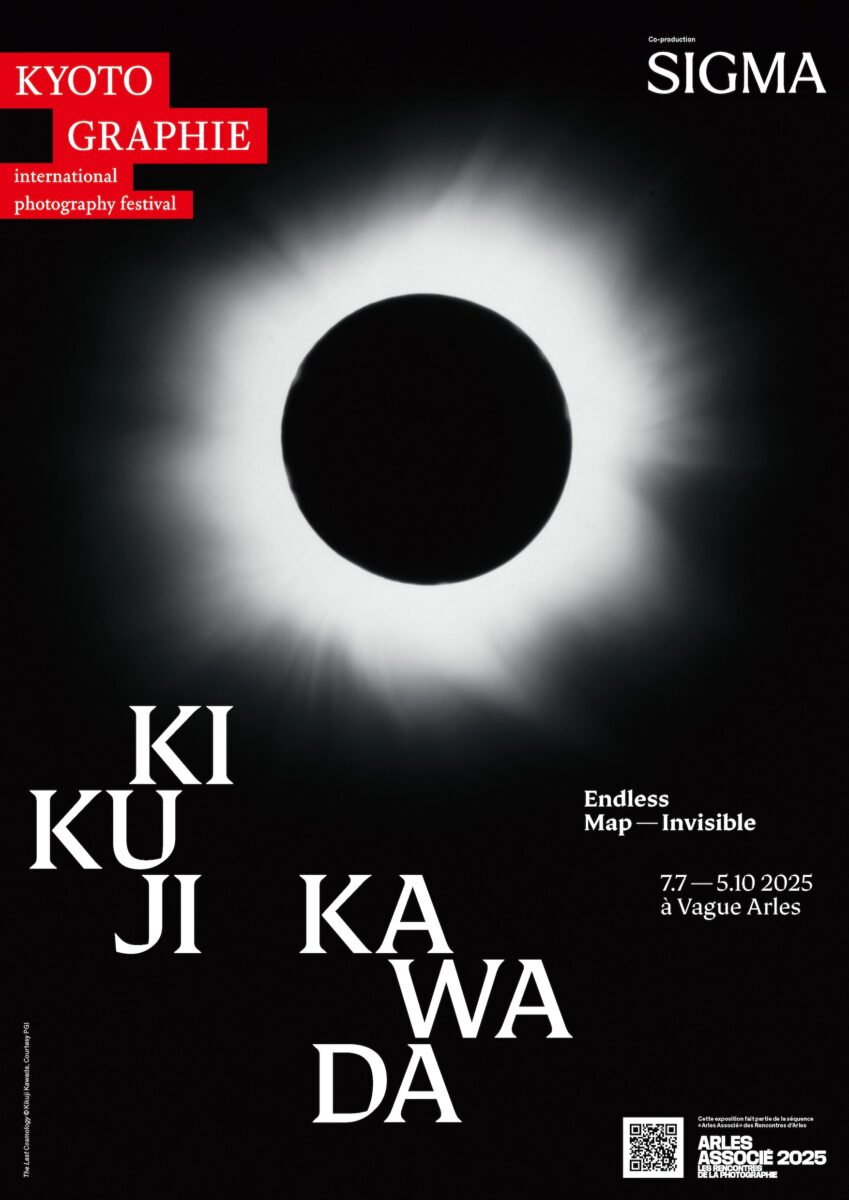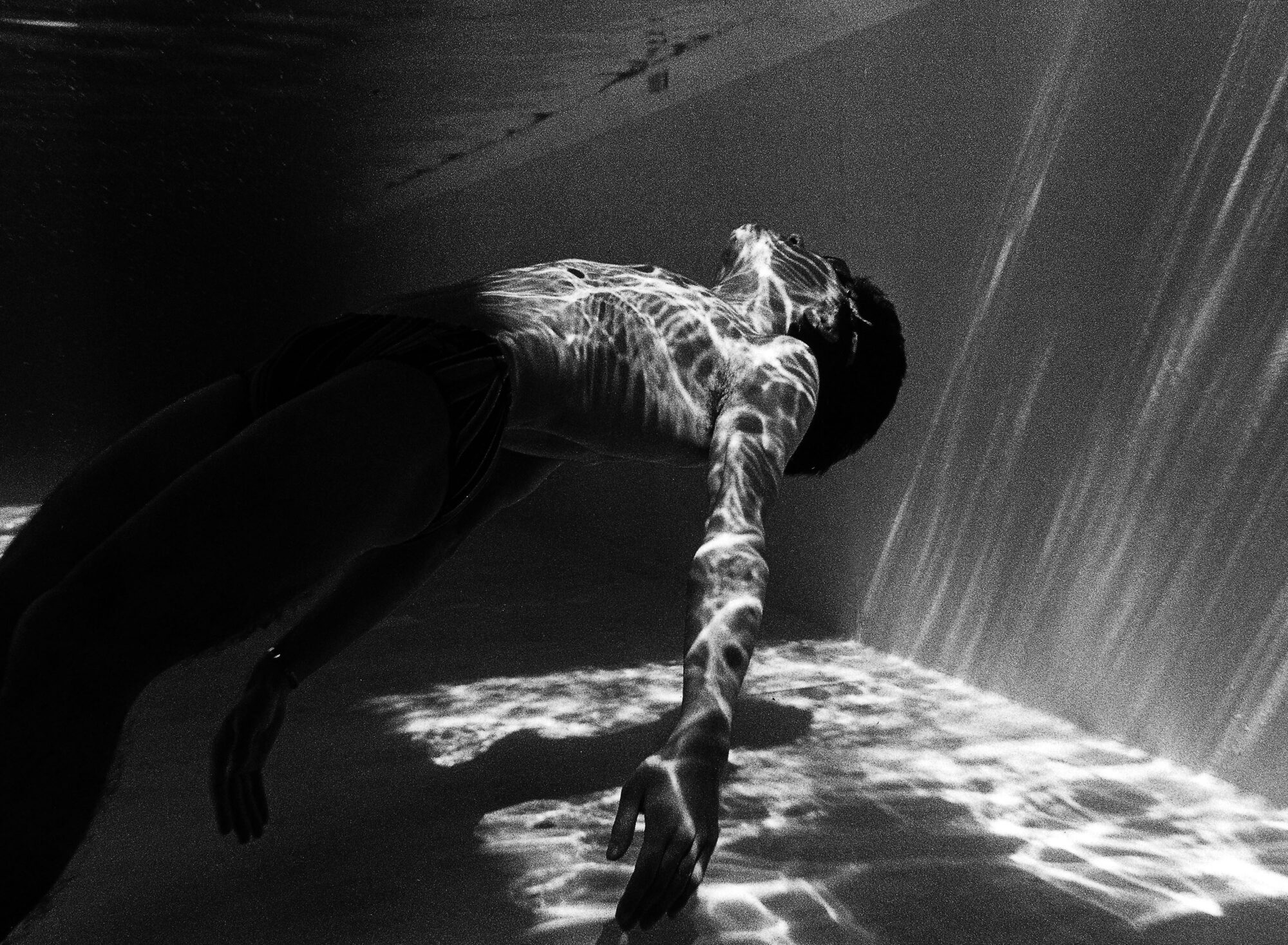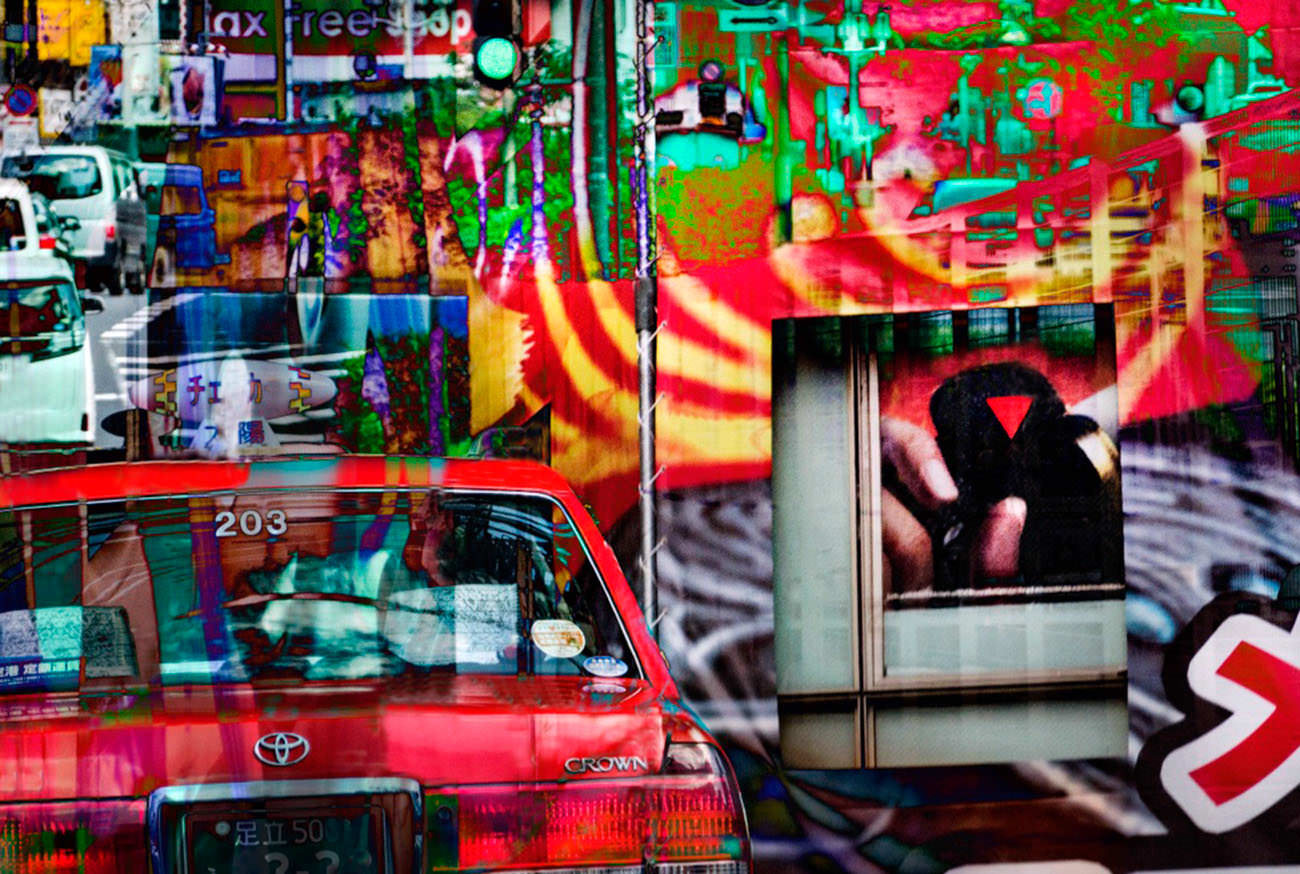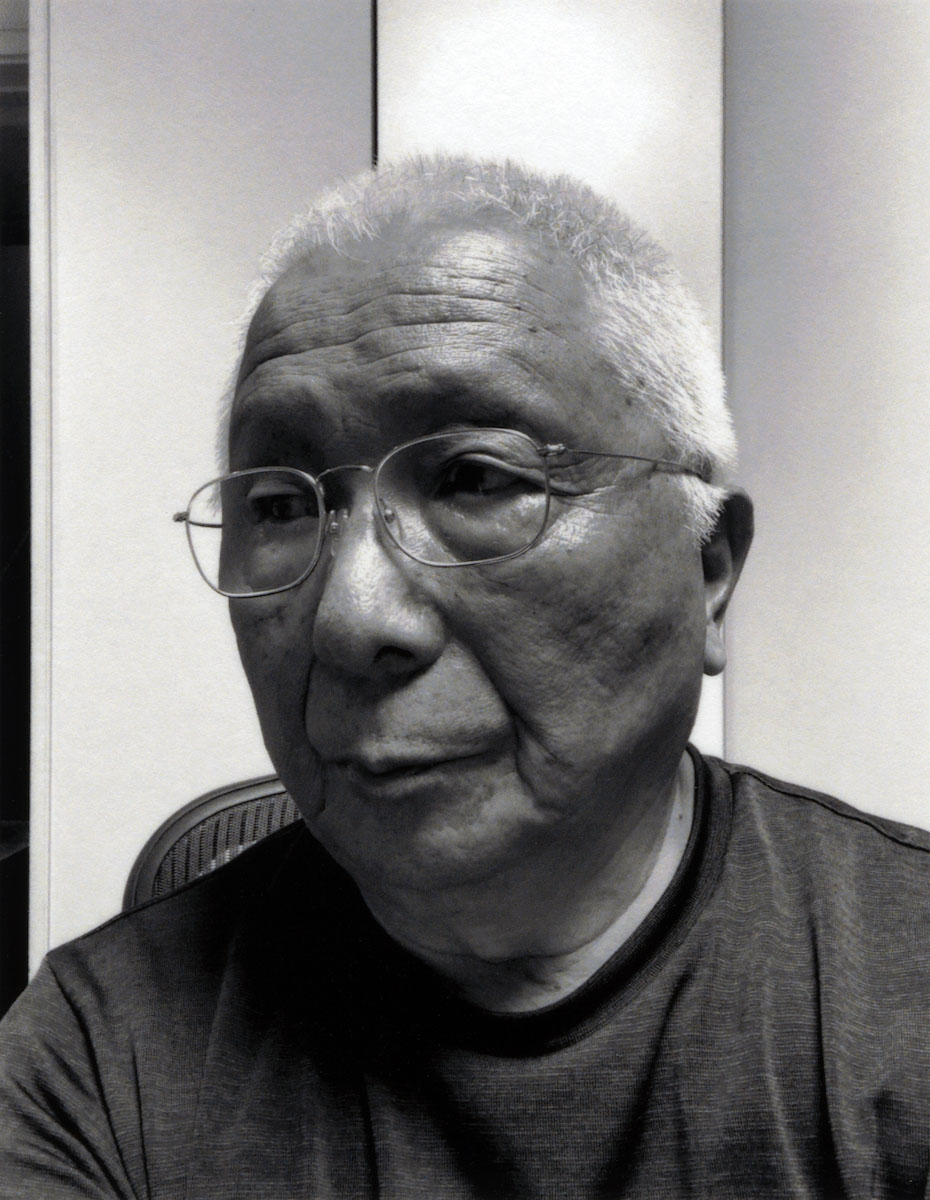Kikuji Kawada: Endless Map – Invisible
Exhibited as part of the “Arles Associé” sequence of the Rencontres d’Arles.
“I never photograph anything other than the here and now. The daily gaze is the starting point of all photography. But once transmitted or printed, the image becomes a distant memory, a light, a shadow, an echo from elsewhere.”
Kikuji Kawada (2025)

Endless Map – Invisible is the first major exhibition in France of Japanese photographer Kikuji Kawada, co-founder of the VIVO collective and a key figure in post-war Japanese photography.
Curated by Sayaka Takahashi of PGI, a gallery in Tokyo representing the artist, this exhibition expands upon the presentation first shown at the 2024 edition of the KYOTOGRAPHIE International Photography Festival.
In this year marking the 80th anniversary of the atomic bombings of Hiroshima and Nagasaki, Endless Map – Invisible brings together, for the first time, photographs from four of Kawada’s most iconic series. It traces six decades of Japanese post-war history through the photographer’s uncompromising gaze, where layers of time and memory intertwine to form a theater of the world.


Event Details
- Title
Kikuji Kawada
Endless Map — Invisible- Co-production
KYOTOGRAPHIE × SIGMA
- Curator
Sayaka Takahashi (PGI)
- Artistic direction
Lucille Reyboz & Yusuke Nakanishi (Co-founders and Directors of KYOTOGRAPHIE)
- Scenography
Hiromitsu Konishi (Space design)
Wataru Hatano (Washi artisan)
Atelier SHL (Framing)- Venue
VAGUE (Arles)
14 Rue de Grille, 13200 Arles, France
Open in Google Maps- Date
July 7 – October 5, 2025
- Opening Hours
9:30 – 19:30
Kikuji Kawada
Kikuji Kawada (born 1933 in Ibaraki, Japan) is a major figure in postwar Japanese photography. After graduating Kawada joined the publishing company Shinchosha as a photographer. He co-founded the legendary VIVO collective in 1959 alongside Akira Satō, Akira Tanno, Shōmei Tōmatsu, Ikko Narahara, and Eikoh Hosoe. Kawada belongs to a generation that profoundly renewed Japanese photographic language during a time of both socio-political and aesthetic upheaval. His book Chizu (The Map), published in 1965, is considered one of the greatest masterpieces in the history of photography. This visual meditation on Japan’s defeat and the nuclear catastrophe, rich in political metaphors and narrative experimentation, disrupted the conventions of the photobook.
Kawada describes his work as capturing “the demons lurking in the era, fixed as shadows of astonishment,” adding that “memory itself could then become the mirror of the artist’s style.” At 92, he continues to renew his vision and revisit his work, maintaining a continuous connection with his audience by regularly sharing his photographic reflections on Instagram.

Kikuji Kawada Interview
June 2025, Tokyo
The exhibition in Arles, The Map / Visions of the Invisible, features works from three of your series: Chizu (The Map), Los Caprichos, and Last Cosmology. What was your intention in presenting these series together?
Rather than following a chronological sequence, the idea is to allow a landscape of images to emerge that wander freely through time and psychological space. The exhibited series weren’t originally conceived as a trilogy, but the images may overlap and form metaphors that are only possible in photography. Somewhere in there, perhaps, lies a vision for a future to come. What is happening precisely is left to the imagination.
Could you elaborate on why you chose to ignore the chronological order?
Visions already move back and forth through time and space so I didn’t see the point in aligning them along the temporal axis in the first place. On the contrary, it seems more realistic to me that images taken years ago would form some connection with images from today or yesterday. I also sometimes revisit older photographs and adjust the coloring from a fresh point of view.
In my impression, the title of your series Los Caprichos – and Chizu as well – doesn’t seem to have a singular focus, but rather hints at something larger and more encompassing. Would you agree?
In the end, images need a box into which they are placed. Coming up with a concise but comprehensive title is an important task in itself that can affect the longevity of the work.
I was looking through etchings by Goya as I thought about the overall impression that the images evoke, and what came to mind in the end was Los Caprichos and Theatrum Mundi.
Framing the chaotic motions of the mind in words is difficult, but capriciousness (Los Caprichos) seemed most apt to me. It is possible that I would choose a different title today. Lately, I have been thinking of titles like “Endless Map” or “Unfinished Continuation” to suggest an ongoing series without an end.
Your debut photobook Chizu (The Map) continues to captivate audiences today. In 2021, you held an exhibition titled Endless Map that featured images from Chizu printed on washi paper. Has anything about the work changed in its transition to a different medium?
Yes, that is inevitable. The work lives within circumstances that continually shift, change, adapt, and transform, either on their own or through external forces, and naturally it will change without us even realizing it. Of course, we may also become aware of the changes somewhere in the process.
For the 2021 exhibition of Chizu – the images had been exhibited in some form numerous times before – the negatives were digitized and the work moved from darkroom to lightroom. The changes in technology and the differences between the times have made me acutely aware how the light changes day to day. The way we perceive what has been captured in a photograph also changes continually. I thought that a different title was needed. The map is endless, and so is our way of seeing. As a result, there may always be new selections or experiments with different media.
The Here and Now has been a consistent focus of your photography. This is particularly evident in your work of the past twenty years, for example in the photobook Vortex or in the projected images of the Kyotographie / Arles exhibitions. You also share your work on Instagram, where we can instantly access the world you capture. Do you seek out distant, unfamiliar places, or do you still find fascination in your everyday surroundings?
There is nothing to photograph but what is here, now. Later, the images can be sent out into the world, on paper or digitally, where they may act like memories or become like a light or a shadow that hints at the existence of something distant, something beyond. The start of photography lies in the everyday gaze.
Over your many decades as a photographer, you’ve witnessed the shift from an era when photography was developed in darkrooms and published through photobooks to today’s world of digital technology and social media. How do you view these changes? Has photography lost or perhaps gained anything in the process?
Photography has always been subject to societal shifts and technological advances. When the world changes, so does the way we record and express ourselves through photography. I can sense the sparks of a new sensibility in the photography of today, but it always remains difficult to get up close to the swirling chaos and underlying currents of our time.
What is photography’s role in expressing the invisible and the unspeakable? What meaning do photographs have in a world that is drowning in images?
Photographs are not the product of conscious thought. Photography relies on sensibility and intuition. The timing of the shutter, for example, is decided almost entirely in the unconscious realm, as if externally programmed. The conscious self is not really involved in that moment. It is our emotions, or perhaps some unconscious sensibility, that makes us press the shutter.
To me, the multilayered space and time of photography always seems to include the possibility for accidents, poetry, new sensibilities and contemporary narratives, something that lets it transcend the everyday world from which it emerges. I strongly feel that photography expands my imagination.
What motivates you to publish photographs on Instagram almost every day?
Perhaps I’m hoping for a signal to tell me about the Here and Now hidden somewhere in the images. Each time, I feel that the many people who kindly take the time to look at them are also sharing in the Here and Now, along with their own doubts.
What significance does Chizu, originally published in 1965, hold today? Do you view the work differently now compared to when you first released it?
Photographs hold a multitude of meanings, and I hope that the demonic images captured through my sensibilities resonate with new viewers. At some point, new visions may manifest in their mind like seven-colored rainbows and, for a moment, transform into a feeling akin to a silent prayer.
What is evoked by a photograph continues to evolve with the times. I wanted to use photography’s concrete, documentary nature but also its inherent power to abstract the horrors of war. Importantly, the polysemous nature of the book format allowed me to visualize what I couldn’t quite achieve in the three-dimensional space of the exhibition. Over the years, Chizu seems to have gained new metaphorical layers of illusion. In my eyes, it is truly becoming an endless map that implicates the future in its resurrection of a complete past.
What are your thoughts on the current state of the world and the continuing existence of nuclear weapons?
Unfortunately the voices calling for nuclear disarmament always disappear into the depths of the earth. Instead of nurturing the seeds for repeating wars, there they grow into a legion of mighty demons. I pray that our destruction doesn’t also extend to Mars or the moon.
What does the camera mean to you? How is it connected to your act of seeing?
The camera and the eyes are the vanguard of the mind. To connect them with the imagination, the rearguard, I use lenses and computers to transform light into something else, summoning various synchronicities in the process to which I then respond.
I can’t write poetry, but sometimes I feel that photography is my substitute. When I revisit photographs on the monitor, occasionally a language-defying scene jumps out from the imagery and becomes part of my inner self.
What do you think of the work of young, contemporary photographers? Is there anything you’d like to say to the current generation?
I strongly sense that they are trying to find a connection to their hearts. I hope they continue to take photographs for as long as they can.
À Arles, vous présentez ensemble les trois œuvres The Map, Los Caprichos et Last Cosmology sous un titre unique :The Map / Visions of the Invisible. Quelle est l’intention derrière ce regroupement sous un même intitulé ?
Ce n’est pas un récit chronologique, mais un enchaînement d’images qui traverse les dimensions du présent et les paysages d’une rêverie intérieure. Je n’avais pas, à l’origine, conçu ces trois œuvres comme un tout, mais peut-être qu’en se superposant, les images ont fini par engendrer une métaphore propre à la photographie. Il se pourrait qu’au creux de ces plis spatio-temporels, se dissimule une vision de ce qui vient. Je ne saurais dire exactement ce qui se joue, mais quelque chose, en silence, appelle à l’imaginaire.
Quel sens donnez-vous au fait de dénouer la chronologie dans vos œuvres ?
La vision, telle une brume légère, traverse librement les dimensions du temps et de l’espace. Je n’ai jamais ressenti le besoin de l’ordonner selon une ligne ou une progression. Il y a parfois plus de vérité dans la résonance entre une image ancienne – oubliée peut-être – et une image d’hier encore vibrante. Il m’arrive aussi de revisiter ces fragments du passé, d’en modifier les teintes sous la lumière du regard d’aujourd’hui. Comme si le temps lui-même acceptait d’être reconfiguré par la mémoire sensible.
J’ai l’impression, et cela vaut aussi pour The Map, que le titre Los Caprichos ne désigne pas quelque chose d’univoque, mais plutôt le nom ou le signe d’un projet plus vaste. Qu’en pensez-vous ?
Le choix d’un titre est une étape importante, même du point de vue du goût. Un jour, en contemplant les eaux-fortes de Goya, j’ai tenté d’imaginer une image capable de saisir l’ensemble de l’œuvre – et ce qui m’est venu à l’esprit, naturellement, ce furent Los Caprichos, ou encore Le théâtre du monde (Teatro Mundi). Quand il s’agit de traduire les élans de l’esprit en mots, je pense que « caprice » (capricho) convient bien – cette impulsion de l’instant, libre et imprévisible. Mais si je devais tout recommencer, je changerais peut-être de titre. Quelque chose comme Endless Map, ou Unfinished Continuation… une série sans fin, en perpétuel mouvement.
Votre œuvre de jeunesse, The Map, continue de susciter l’étonnement dans le monde entier. En 2021, vous avez publié une série intitulée Endless Map. Que pouvez-vous nous dire de cette transformation du médium et de votre expression ?
C’est une évolution naturelle. Nous vivons dans un monde où les supports changent – volontairement ou non –, où ils se transforment parfois à notre insu, parfois de manière consciente. Lors de la nouvelle exposition de The Map en 2021, les négatifs ont été numérisés, les tirages ont quitté la chambre noire pour entrer dans la chambre claire. Avec cette mutation scientifique et technique, j’ai senti, presque physiquement, que la lumière du quotidien avait changé. Le regard porté sur les images se transforme lui aussi. J’ai compris qu’il fallait aussi faire évoluer le titre. Endless Map désigne cette continuité du regard à travers le temps. C’est ce qui m’a conduit à tenter de nouvelles sélections, à explorer de nouveaux supports.
Votre travail photographique a toujours été centré sur le « ici et maintenant ». Dans des œuvres telles que Vortex, ou dans les projections présentées à KYOTOGRAPHIE et à Arles, cette attention s’est intensifiée au cours des vingt dernières années. Désormais, grâce à Instagram, ces images sont immédiatement accessibles, abolissant le délai entre la prise de vue et le regard du spectateur. Ce qui se trouve juste au bout du regard quotidien conserve-t-il, selon vous, sa puissance d’attraction, sans qu’il soit besoin d’aller loin ?
Quand je photographie, ce n’est jamais autre chose que « ici et maintenant ».
Mais cette présence, une fois imprimée sur le papier ou diffusée dans l’éther numérique, devient parfois une réminiscence lointaine – une lumière ou une ombre qui évoque un ailleurs, une époque révolue. C’est dans le prolongement du regard quotidien que commence toute photographie.
Vous êtes photographe depuis longtemps. Que pensez-vous du passage d’une époque dominée par la chambre noire et le livre, à celle du numérique et des réseaux sociaux ? Comment analysez-vous cette transformation ? Qu’est-ce que la photographie a perdu ou gagné ?
La photographie est liée aux changements sociaux et aux progrès scientifiques. Il est donc naturel que les méthodes de documentation et d’expression changent. J’ai l’impression que les photos d’aujourd’hui produisent des étincelles de sensibilité nouvelles, mais aussi qu’il est devenu difficile d’approcher les mouvements profonds et le chaos de notre époque.
Selon vous, quel rôle joue la photographie pour exprimer « l’invisible » ou « ce qui ne parle pas ». Quel rôle peut-elle encore avoir dans un monde saturé d’images ?
La photographie ne semble pas être une activité qui se pratique en réfléchissant, en pensant. Le moment où l’on appuie sur le déclencheur tient plus du ressenti, de l’automatisme, voire de l’inconscient. Ce n’est pas l’intériorité qui décide, mais peut-être une sensibilité émotionnelle et inconsciente qui pousse à appuyer sur le déclencheur. En réfléchissant à ce que les images photographiques font apparaître – cette part d’aléatoire, de saut poétique, et de narrations nouvelles ancrées dans le présent – j’ai le sentiment que l’espace-temps de la photographie laisse toujours émerger quelque chose au-delà du quotidien. Je ressens avec force combien elle élargit le champ de l’imaginaire.
Vous publiez chaque jour des images sur Instagram. Qu’est-ce qui vous motive à diffuser vos images sur les réseaux sociaux ?
Il y a peut-être quelque part un signal, une sorte d’appel silencieux, qui me dit que « ici et maintenant » se cache quelque chose de l’image. Et à chaque publication, le fait que tant de personnes regardent mes images me fait penser qu’elles partagent avec moi cet « ici et maintenant », en y projetant elles aussi une part de questionnement, d’étonnement, face à cette image.
Quelle est, selon vous, la signification de The Map, publiée en 1965, dans la société actuelle ? Votre regard sur cette œuvre a-t-il changé ?
Une image naît toujours habitée d’une multiplicité de sens. J’aimerais qu’elle puisse susciter une forme de résonance sensible face à ces visions, parfois sombres, parfois presque démoniaques, que ma perception a tenté de saisir. Je pense que ces visions nouvelles, un jour, se transformeront intérieurement – tel un arc-en-ciel aux sept couleurs – en une émotion fugace, semblable à une prière. Les visions suggérées par la photographie ne cessent d’évoluer avec le temps. Ce n’est pas seulement le pouvoir documentaire ou testimonial qui m’intéresse, mais aussi la possibilité d’abstraire, par la force de l’image, les ravages de la guerre – de faire fusionner ces dimensions. Ce que je n’ai pas pu accomplir dans l’espace d’exposition, j’ai pu le visualiser à travers la polysémie que permet le médium du livre – et cela me semble être une avancée significative. The Map me semble contenir de plus en plus une métaphore de l’illusion, du mirage. Pour moi, il devient une Endless Map, une carte infinie, qui tout en suggérant l’avenir, parvient à faire ressurgir un passé parfait (The Perfect Past).
Que pensez-vous du contexte mondial actuel, où la menace nucléaire ne faiblit pas ?
Les voix appelant à l’abolition de l’arme nucléaire s’enfoncent toujours profondément dans les sols de la Terre. Elles se transforment peu à peu en graines de guerres, qui ne cessent de germer, jusqu’à devenir un démon gigantesque. Je continue de prier pour que, au moins, la Lune, Mars et ce qu’il reste d’ailleurs, ne soient pas eux aussi souillées à leur tour.
Qu’est-ce qu’un appareil photo pour vous ? Comment se noue selon vous l’acte de “voir” et l’appareil photo ?
L’appareil est l’avant-garde du cœur, relié à l’œil. Pour que l’imagination – l’arrière-garde – s’y connecte, l’objectif et l’ordinateur doivent transmuer la lumière et faire surgir diverses synchronicités. Je ne suis pas capable d’écrire de poésie, mais il m’arrive de penser que photographier en est une forme de substitut. Parfois, soudainement, ou par hasard, je reviens sur une image affichée sur l’écran de mon ordinateur, et lorsque des combinaisons d’images font surgir une scène que je ne saurais exprimer par des mots, alors il se peut que cette image devienne, en quelque sorte, mon cœur lui-même, de ma propre intériorité.
Comment percevez-vous le travail des jeunes photographes aujourd’hui ? Que souhaitez-vous transmettre aux générations futures ?
Je ressens avec force leur tentative de chercher un lien avec le cœur, l’intériorité. J’espère de tout cœur que le travail de captation par l’image pourra se poursuivre aussi longtemps que possible.
- Co-Production
-
-
- In Collaboration With
-
-
- Program
-
-
- Media Partners
-
-






